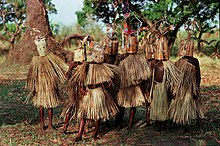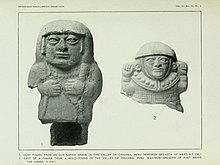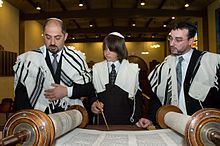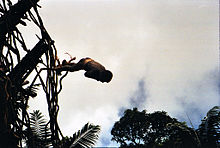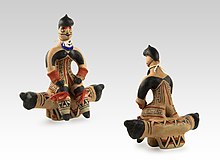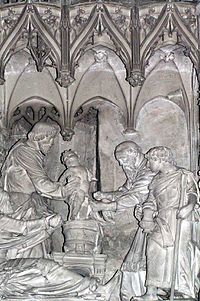Rite of passage
|
Read other articles:

INTS7 المعرفات الأسماء المستعارة INTS7, C1orf73, INT7, integrator complex subunit 7 معرفات خارجية الوراثة المندلية البشرية عبر الإنترنت 611350 MGI: MGI:1924315 HomoloGene: 9136 GeneCards: 25896 علم الوجود الجيني الوظيفة الجزيئية • GO:0001948، GO:0016582 ربط بروتيني المكونات الخلوية • integrator complex• صبغي• بلازم نووي• نواة• سيتوب�…

American Mormon leader (1792–1872) W. W. PhelpsPersonal detailsBornWilliam Wines Phelps(1792-02-17)February 17, 1792Hanover Township, New Jersey, USDiedMarch 17, 1872(1872-03-17) (aged 80)Salt Lake City, Utah TerritoryResting placeSalt Lake City Cemetery40°46′37″N 111°51′29″W / 40.777°N 111.858°W / 40.777; -111.858 (Salt Lake City Cemetery)OccupationChurch printerTitleScribe to Joseph Smith, composer of numerous LDS hymnsSpouse(s)Stella Waterman…

Disambiguazione – Se stai cercando altri significati, vedi Danubio (disambigua). DanubioIl Danubio a BudapestStati Germania Austria Slovacchia Ungheria Croazia Serbia Romania Bulgaria Moldavia Ucraina Lunghezza2 858 km Portata media6 500 m³/s 30 km prima di Passavia: 580 m³/sVienna: 1900 m³/sBudapest: 2350 m³/sprima del Delta: 6500 m³/s Bacino idrografico801 463 km² Altitudine sorgente1 078 m s.l.m. NasceDonauesch…

Данио-рерио Научная классификация Домен:ЭукариотыЦарство:ЖивотныеПодцарство:ЭуметазоиБез ранга:Двусторонне-симметричныеБез ранга:ВторичноротыеТип:ХордовыеПодтип:ПозвоночныеИнфратип:ЧелюстноротыеГруппа:Костные рыбыКласс:Лучепёрые рыбыПодкласс:Новопёрые рыбыИнфр�…

Державний комітет телебачення і радіомовлення України (Держкомтелерадіо) Приміщення комітетуЗагальна інформаціяКраїна УкраїнаДата створення 2003Керівне відомство Кабінет Міністрів УкраїниРічний бюджет 1 964 898 500 ₴[1]Голова Олег НаливайкоПідвідомчі орг�…

提示:此条目页的主题不是中華人民共和國最高領導人。 中华人民共和国 中华人民共和国政府与政治系列条目 执政党 中国共产党 党章、党旗党徽 主要负责人、领导核心 领导集体、民主集中制 意识形态、组织 以习近平同志为核心的党中央 两个维护、两个确立 全国代表大会 (二十大) 中央委员会 (二十届) 总书记:习近平 中央政治局 常务委员会 中央书记处 中�…
2020年夏季奥林匹克运动会波兰代表團波兰国旗IOC編碼POLNOC波蘭奧林匹克委員會網站olimpijski.pl(英文)(波兰文)2020年夏季奥林匹克运动会(東京)2021年7月23日至8月8日(受2019冠状病毒病疫情影响推迟,但仍保留原定名称)運動員206參賽項目24个大项旗手开幕式:帕维尔·科热尼奥夫斯基(游泳)和马娅·沃什乔夫斯卡(自行车)[1]闭幕式:卡罗利娜·纳亚(皮划艇)[2…

1944 massacre of Poles by Ukrainian Nazi collaborators Huta Pieniacka massacreMonument at the site of the village Huta PieniackaŁuckBrześćLwówKrakówPoznańWarsawWilnoStanisławówclass=notpageimage| Location of Huta Pieniacka massacre(map of Poland before the 1939 invasion)Date28 February 1944LocationHuta Pieniacka, Occupied Poland (Nazi German Distrikt Galizien)TypeMassacre of Polish inhabitantsMotiveAnti-Catholicism, Anti-Polish sentiment, Greater Ukraine, UkrainisationParticipantsUkraini…

CA63Stasiun Ōdaka大高駅Pintu masuk Stasiun ŌdakaLokasiTsuruta-45-1 Ōdakachō, Midori-ku, Nagoya-shi, Aichi-ken 459-8001JepangKoordinat35°4′10″N 136°56′25″E / 35.06944°N 136.94028°E / 35.06944; 136.94028Koordinat: 35°4′10″N 136°56′25″E / 35.06944°N 136.94028°E / 35.06944; 136.94028Operator JR CentralJalur Jalur Utama TokaidoLetak353.6 kilometer dari TokyoJumlah peron1 peron sampingInformasi lainStatusMemiliki stafKode s…

Cunicoli di ClaudioImbocchi del cunicolo MaggioreCiviltàromana EpocaI secolo - VI secolo LocalizzazioneStato Italia ComuneAvezzano, Capistrello AmministrazioneEnteSoprintendenza Archeologia, Belle Arti e PaesaggioConsorzio di bonifica Liri-Garigliano Sito webportalecultura.egov.regione.abruzzo.it/abruzzocultura/loadcard.do?id_card=114880&force=1&theme=aritnew Mappa di localizzazione Modifica dati su Wikidata · ManualeCoordinate: 41°59′18.7″N 13°26′00.2″E / &…

Pengolahan sampah di Iran yang merupakan negara berkembang Perdagangan sampah global adalah kegiatan niaga (jual beli) sampah skala internasional antara negara-negara demi pengolahan lebih lanjut baik itu proses pembuangan ataupun proses daur ulang. Limbah beracun dan berbahaya sering dikirim ke negara berkembang oleh negara-negara maju.[1] Laporan dari Bank Dunia yang bertajuk 'What a Waste: A Global Review of Solid Waste Management', isi laporan tersebut menjelaskan tentang jumlah limb…

Comic book character Comics character Ned LeedsNed Leeds, in The Amazing Spider-Man vol. 1 #245 (October 1983).Art by John Romita Jr.Publication informationPublisherMarvel ComicsFirst appearanceThe Amazing Spider-Man #18 (November 1964)Created byStan Lee (writer)Steve Ditko (artist)In-story informationFull nameEdward Ned LeedsSpeciesHumanPlace of originHuntington, New YorkTeam affiliationsDaily BugleSupporting character ofSpider-ManBaron MordoNotable aliasesHobgoblinAbilitiesExpert deductive rea…

American actress (born 1970) Nia LongLong in February 2012BornNia Talita Long (1970-10-30) October 30, 1970 (age 53)New York City, New York, U.S.OccupationActressYears active1986–presentPartnerIme Udoka (2010–2022)Children2RelativesSommore (half-sister) Nia Talita Long (born October 30, 1970)[1] is an American actress. Best known for her work in Black cinema,[2] Long rose to prominence after starring in the film Boyz n the Hood (1991), and for her portrayal of Beull…

Peta lokasi Munisipalitas Randers Munisipalitas Randers adalah sebuah kawasan pemukiman (Denmark: kommune) di Region Midtjylland di semenanjung Jutlandia di Denmark tengah. Munisipalitas Randers memiliki luas sebesar 793 km² dan memiliki populasi sebesar 93.644 jiwa. Referensi Municipal statistics: NetBorger Kommunefakta Diarsipkan 2007-08-12 di Wayback Machine., delivered from KMD aka Kommunedata (Municipal Data) Municipal merges and neighbors: Eniro new municipalities map Diarsipkan 2007…

Head of the Catholic Church from 1740 to 1758 Benedict XIV redirects here. For the name used by two antipopes, see Antipope Benedict XIV. Cardinal Lambertini redirects here. Not to be confused with Egano Righi-Lambertini. PopeBenedict XIVBishop of RomePortrait of Benedict XIV by Pierre Subleyras, 1746ChurchCatholic ChurchPapacy began17 August 1740Papacy ended3 May 1758PredecessorClement XIISuccessorClement XIIIOrdersOrdination2 July 1724 by Pope Benedict XIIIConsecration16 July 1724by Bened…

Para otros usos de este término, véase Bogotá (desambiguación). «Santafé» redirige aquí. Para otras acepciones, véase Santa Fe. BogotáBogotá, Distrito Capital Capital de Colombia Centro, La Candelaria, Monserrate, Capitolio Nacional de Colombia, Museo del Oro y Centro Internacional visto desde el Cerro de Guadalupe. BanderaEscudo Otros nombres: La Atenas Suramericana, La Ciudad de Todos, La Capital Mundial del Teatro,[11] Muy Noble y Muy Leal Ciudad.[12] Lema: 2600 metro…

1978 U.S. federal law deregulating the airline industry This article includes a list of general references, but it lacks sufficient corresponding inline citations. Please help to improve this article by introducing more precise citations. (January 2012) (Learn how and when to remove this message) Airline Deregulation ActLong titleAn Act to amend the Federal Aviation Act of 1958, to encourage, develop, and attain an air transportation system which relies on competitive market forces to determine …

2001 studio album by the, Yonder Mountain String BandTown by TownStudio album by theYonder Mountain String BandReleased2001RecordedJanuary 7–March 19, 2001GenreProgressive bluegrassJam bandLength59:46LabelFrog Pad RecordsProducerTim O'BrienYonder Mountain String Band chronology Mountain Tracks: Volume 1(2001) Town by Town(2001) Mountain Tracks: Volume 2(2002) Professional ratingsReview scoresSourceRatingAllmusic[1] Town by Town is the third studio album by the progressive b…

American college basketball season 1974–75 Illinois Fighting Illini men's basketballConferenceBig Ten ConferenceRecord8–18 (4–14 Big Ten)Head coachGene Bartow (1st season)Assistant coaches Tony Yates (1st season) LeRoy Hunt (1st season) MVPRick SchmidtCaptainRick SchmidtHome arenaAssembly HallSeasons← 1973–741975–76 → 1974–75 Big Ten Conference men's basketball standings vte Conf Overall Team W L PCT W L PCT No. 3 Indiana 18…

Questa voce sull'argomento cantanti statunitensi è solo un abbozzo. Contribuisci a migliorarla secondo le convenzioni di Wikipedia. Segui i suggerimenti del progetto di riferimento. Kelly Price Nazionalità Stati Uniti GenereRhythm and bluesSoul Periodo di attività musicale1992 – in attività Sito ufficiale Modifica dati su Wikidata · Manuale Kelly Price (New York, 4 aprile 1973) è una cantante statunitense di genere R&B/soul. Price è nata a Queens, N…
